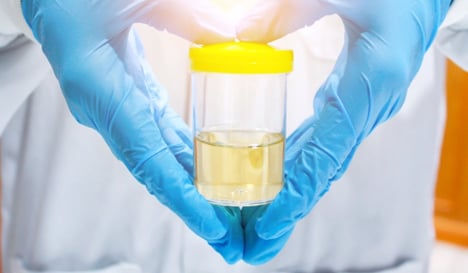Share this
VAMS dried urine samples for measuring antimalarial levels
by James Rudge, PhD, Technical Director, Trajan on Feb 7, 2022 9:00:00 AM
 An article published by Nicolas Taudon et al at the Armed Forces Biomedical Research Institute (France) in the December 2020 issue of Journal of Analytical Methods in Chemistry, reported on a method for measuring an antimalarial medication from dried urine VAMS samples collected on Mitra® devices based on VAMS® technology.
An article published by Nicolas Taudon et al at the Armed Forces Biomedical Research Institute (France) in the December 2020 issue of Journal of Analytical Methods in Chemistry, reported on a method for measuring an antimalarial medication from dried urine VAMS samples collected on Mitra® devices based on VAMS® technology.
The paper is entitled “A Validated Volumetric Absorptive Microsampling-Liquid Chromatography Tandem Mass Spectrometry Method to Quantify Doxycycline Levels in Urine: An Application to Monitor the Malaria Chemoprophylaxis Compliance.”
The paper describes the development and validation of an assay for the antimalarial drug from both liquid urine samples and dried urine samples, including a pilot field test on 29 volunteers. Due to the sensitivity of the VAMS assay, the method was found to reliably monitor retroactively, measuring drug levels for up to 4 days prior to the last dose taken. The group developed a method on Mitra devices with VAMS, reporting that “Results achieved in the presented work showed that doxycycline CP compliance in the field could easily be monitored using a fully calibrated volumetric absorptive microsampling device,” such as the Mitra.
The Global Impact of Malaria
The paper begins by reporting that in 2017, there were 219M global cases of Malaria that regrettably resulted in 435,000 deaths. Sadly, most of these cases occurred in the pediatric population in Africa. The research group further reported that 25-30M people annually travel to Africa in malaria-endemic areas, including 10,000 French soldiers, international workers, and tourists. As a result, as many as 30,000 malaria cases are reported each year. Compliance to prophylactic antimalarial medication is key to reducing this patient burden.
Challenges with Doxycycline Compliance
The study paper from Taudon et al discusses how French armed forces are given 100 mg of oral doxycycline for chemoprophylaxis (CP) however it further describes the fact that there is a strong correlation between incidents of malaria and lack of CP compliance. Lack of consistency in taking the antimalarial doxycycline is a trend that has also been reported by other armies. There are several reasons for this lack of compliance, including the challenges of working in combat zones as well as prematurely halting of CP when leaving malaria-affected regions.
Monitoring Use & Efficacy of the Antimalarial Doxycycline
Because doxycycline is, in part, eliminated by urine (35-60%), urine can be used as a suitable matrix for measuring drug levels and, hence, compliance. Furthermore, urine can also be used to monitor drug levels in an individual’s system several days after administration. However, the researchers report that the cost of transporting frozen urine is high, so a dried matrix solution was desirable. The paper highlighted that DBS is “not available for quantitation” due to poor sampling reproducibility.
Object of the Doxycycline Study
To develop a simple dried urine VAMS assay to monitor CP of doxycycline for people in malaria affected areas to ensure that samples remain stable during transport to a laboratory without the need for freezing.
Sample Extraction Study Methods & Findings
- Samples were extracted from the VAMS tips of Mitra devices (10 µL) in a mixture of H¬2O-ACN and TFA-acetic acid and IS using both vortex and centrifugation. This was compared to results from 10 µL wet urine dilution in a similar diluent.
- Validation:
o For selectivity, 6 different sources of urine were compared to look for interferences.
o Inter- and intra-run precision was found to be below 14%, with accuracy ranging between 96-106%.
o Extraction recovery was obtained at low, medium, and high QC samples for 6 replicates and was found to be 108.7% (mean RSD = 5.4%). Mean recovery was 109% (%RSD, 7.0%). The slight +ve bias in the results was thought to be due to a slight solvent loss.
o Carryover was controlled and Matrix effect was measured from six healthy volunteers from whom 6 different batches of doxycycline were tested and passed.
o Targeted LOQ was found to be 250 ng/mL with 11% accuracy. The LOD was found to be 166 ng/mL.
o In terms of drug response relationship, inter-day assays were prepared on different days (n=6). The Coeff of determination was greater than 0.996 for each condition tested. Moreover, the %RSD on the slope was better for Mitra devices (10.21%) compared to the dilution experiment (15.1%).
o A 1-month stability of doxycycline was observed from Mitra devices in RT (sealed in the dark in a specimen bag with desiccant) with accuracy and precision values of the two concentrations studied as 91.0; 114.6% and 2.5; 13.1%. After the one-month period at RT, unacceptable losses were observed.
o Comparing data from 29 urinary samples from volunteers taking 1 dose of the drug per day, the R2 value when comparing the wet and dried sampling methods was 0.9328 with a ~6% positive bias seen with the dried samples compared to the wet.
Study Authors’ Discussion and Conclusions
- Two methods for measuring doxycycline were developed. One a wet method and the other “using a perfectly calibrated microsampling device [Mitra].”
- Based on LLQ achieved, as well as the half-life of plasma being > 16h, and the observed good stability of the dried sample, the team could use the method to “back-monitor” medication that had been taken up to 4 days prior to analysis.
- The stability of the antimalarial drug on Mitra devices (sealed in specimen bags with desiccant away from light) was found to be 31 days at RT and 12 months when stored in the freezer (-80 °C).
- “Results obtained on samples collected from workers under doxycycline CP were similar to the two methods, showing that the VAMS® [Mitra] device is a relevant collection alternative.”
- They commented that Mitra devices were “easy to use” and could be “routinely employed and extended to other applications in the field.”
One final point was that it was important to conduct stability experiments for any new drug development when considering conditions in transit.
Final Thoughts from Neoteryx
The world continues to focus in on fighting the COVID-19 pandemic—at the time of writing this literature review in early 2022, 307M cases and 5.49M COVID-related deaths have been reported worldwide. However, the pressures of the pandemic can sometimes overshadow other global health crises such as malaria, which in 2017 alone, caused 219M cases globally and 435,000 deaths. Simple actions, such as improvements in compliance to malaria chemoprophylaxis, can help to mitigate some of these cases and the use of dried VAMS urine samples can be an excellent tool to monitor those taking such preventative antimalarial medications.
This study paper was summarized for our readers by James Rudge, PhD, Neoteryx Technical Director. This is curated content. To learn more about the important research outlined in this review, visit the original article published in the Journal of Analytical Methods in Chemistry.
You can access this paper and others on dried urine microsampling with Mitra and VAMS in our Technical Resource Library.

Share this
- Microsampling (206)
- Research, Remote Research (119)
- Venipuncture Alternative (105)
- Clinical Trials, Clinical Research (83)
- Mitra® Device (73)
- Therapeutic Drug Monitoring, TDM (51)
- Dried Blood Spot, DBS (39)
- Biomonitoring, Health, Wellness (30)
- Infectious Disease, Vaccines, COVID-19 (24)
- Blood Microsampling, Serology (23)
- Omics, Multi-Omics (21)
- Decentralized Clinical Trial (DCT) (20)
- Specimen Collection (18)
- Toxicology, Doping, Drug/Alcohol Monitoring, PEth (17)
- Skin Microsampling, Microbiopsy (14)
- hemaPEN® Device (13)
- Preclinical Research, Animal Studies (12)
- Pharmaceuticals, Drug Development (9)
- Harpera Device (7)
- Industry News, Microsampling News (5)
- Antibodies, MAbs (3)
- Company Press Release, Product Press Release (3)
- Environmental Toxins, Exposures (1)
- July 2025 (1)
- May 2025 (1)
- April 2025 (2)
- December 2024 (2)
- November 2024 (1)
- October 2024 (3)
- September 2024 (1)
- June 2024 (1)
- May 2024 (1)
- April 2024 (4)
- March 2024 (1)
- February 2024 (2)
- January 2024 (4)
- December 2023 (3)
- November 2023 (3)
- October 2023 (3)
- September 2023 (3)
- July 2023 (3)
- June 2023 (2)
- April 2023 (2)
- March 2023 (2)
- February 2023 (2)
- January 2023 (3)
- December 2022 (2)
- November 2022 (3)
- October 2022 (4)
- September 2022 (3)
- August 2022 (5)
- July 2022 (2)
- June 2022 (2)
- May 2022 (4)
- April 2022 (3)
- March 2022 (3)
- February 2022 (4)
- January 2022 (5)
- December 2021 (3)
- November 2021 (5)
- October 2021 (3)
- September 2021 (3)
- August 2021 (4)
- July 2021 (4)
- June 2021 (4)
- May 2021 (4)
- April 2021 (3)
- March 2021 (5)
- February 2021 (4)
- January 2021 (4)
- December 2020 (3)
- November 2020 (5)
- October 2020 (4)
- September 2020 (3)
- August 2020 (3)
- July 2020 (6)
- June 2020 (4)
- May 2020 (4)
- April 2020 (3)
- March 2020 (6)
- February 2020 (3)
- January 2020 (4)
- December 2019 (5)
- November 2019 (4)
- October 2019 (2)
- September 2019 (4)
- August 2019 (4)
- July 2019 (3)
- June 2019 (7)
- May 2019 (6)
- April 2019 (5)
- March 2019 (6)
- February 2019 (5)
- January 2019 (8)
- December 2018 (3)
- November 2018 (4)
- October 2018 (7)
- September 2018 (6)
- August 2018 (5)
- July 2018 (8)
- June 2018 (6)
- May 2018 (5)
- April 2018 (6)
- March 2018 (4)
- February 2018 (6)
- January 2018 (4)
- December 2017 (2)
- November 2017 (3)
- October 2017 (2)
- September 2017 (4)
- August 2017 (2)
- July 2017 (4)
- June 2017 (5)
- May 2017 (6)
- April 2017 (6)
- March 2017 (5)
- February 2017 (4)
- January 2017 (1)
- July 2016 (3)
- May 2016 (1)
- April 2016 (2)


No Comments Yet
Let us know what you think